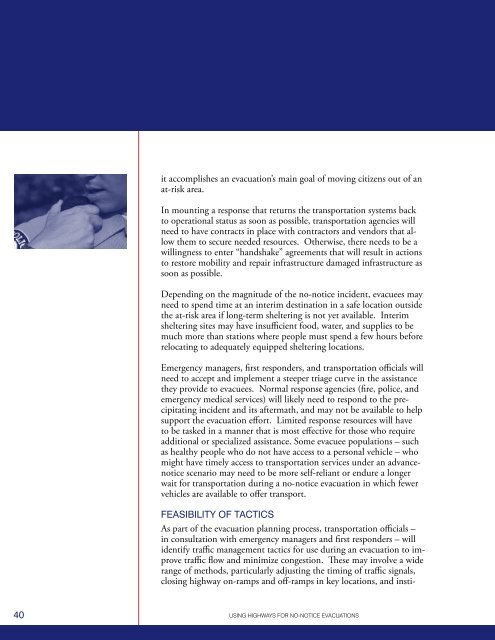using highways for no-notice evacuations - FHWA Operations - U.S. ...
using highways for no-notice evacuations - FHWA Operations - U.S. ...
using highways for no-notice evacuations - FHWA Operations - U.S. ...
Create successful ePaper yourself
Turn your PDF publications into a flip-book with our unique Google optimized e-Paper software.
it accomplishes an evacuation’s main goal of moving citizens out of anat-risk area.In mounting a response that returns the transportation systems backto operational status as soon as possible, transportation agencies willneed to have contracts in place with contractors and vendors that allowthem to secure needed resources. Otherwise, there needs to be awillingness to enter “handshake” agreements that will result in actionsto restore mobility and repair infrastructure damaged infrastructure assoon as possible.Depending on the magnitude of the <strong>no</strong>-<strong>no</strong>tice incident, evacuees mayneed to spend time at an interim destination in a safe location outsidethe at-risk area if long-term sheltering is <strong>no</strong>t yet available. Interimsheltering sites may have insufficient food, water, and supplies to bemuch more than stations where people must spend a few hours be<strong>for</strong>erelocating to adequately equipped sheltering locations.Emergency managers, first responders, and transportation officials willneed to accept and implement a steeper triage curve in the assistancethey provide to evacuees. Normal response agencies (fire, police, andemergency medical services) will likely need to respond to the precipitatingincident and its aftermath, and may <strong>no</strong>t be available to helpsupport the evacuation ef<strong>for</strong>t. Limited response resources will haveto be tasked in a manner that is most effective <strong>for</strong> those who requireadditional or specialized assistance. Some evacuee populations – suchas healthy people who do <strong>no</strong>t have access to a personal vehicle – whomight have timely access to transportation services under an advance<strong>no</strong>ticescenario may need to be more self-reliant or endure a longerwait <strong>for</strong> transportation during a <strong>no</strong>-<strong>no</strong>tice evacuation in which fewervehicles are available to offer transport.feasibility of tacticsAs part of the evacuation planning process, transportation officials –in consultation with emergency managers and first responders – willidentify traffic management tactics <strong>for</strong> use during an evacuation to improvetraffic flow and minimize congestion. These may involve a widerange of methods, particularly adjusting the timing of traffic signals,closing highway on-ramps and off-ramps in key locations, and insti-40 USING HIGHWAYS FOR NO-NOTICE EVACUATIONS
















